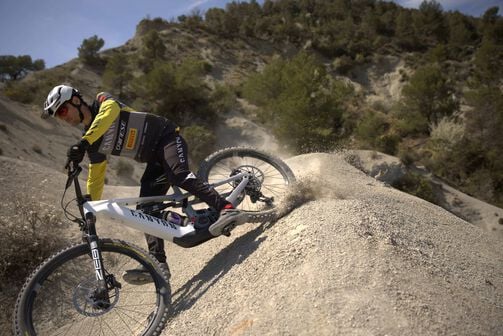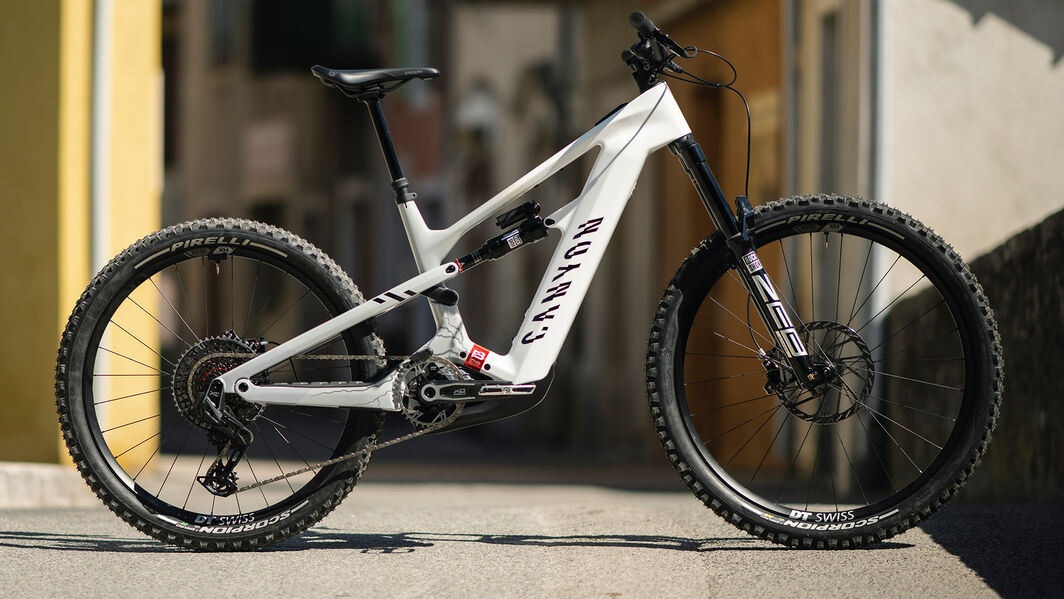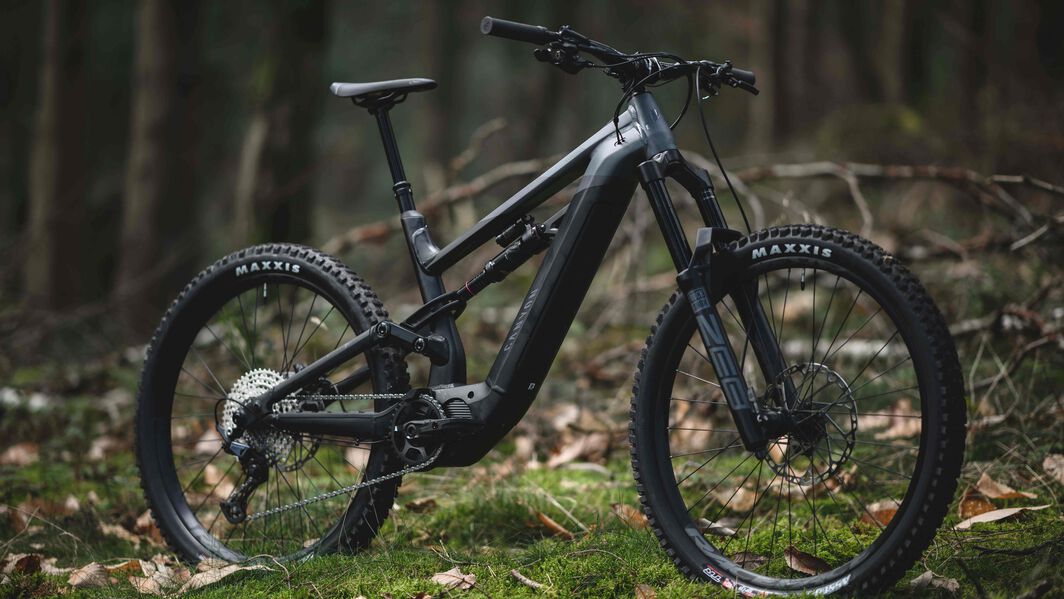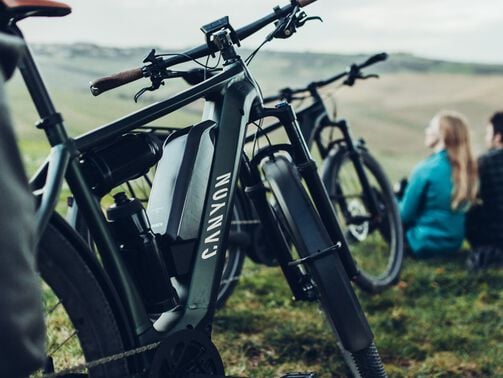How to choose an electric mountain bike: Expert buying guide
Excited by e-MTBs? We walk you through the Canyon range to find the right bike for you.


Buying an electric mountain bike can be a daunting task. Not only do you need to understand the technical jargon associated with mountain bikes, you now also need to decipher motor and battery specs too. This buying guide will walk you through that motor and battery tech, explain how to find the right bike for your riding style, and address other details you should keep in mind when searching for your perfect e-MTB.
Contents
What is an electric mountain bike?
An e-MTB is a mountain bike fitted with a small motor that assists the rider. The word “assist” is crucial here. The goal of an e-MTB motor is to support the rider, not replace them, and the law requires that you need to pedal for the motor to work.
Why choose an electric mountain bike?
There are many reasons to choose an e-MTB, but we think the number one reason is fun. By adding some assistance to your riding, you can do more of the parts of the ride you enjoy, and less of the parts you don’t. Some people like e-MTBs because they mean they can cover more ground in the time they have for riding, some people want to use the motor to tackle steeper, more challenging climbs, and some people might just want a little help on the way up. There is no right or wrong answer here; all that matters is whether or not an e-MTB will prove more fun for you on the trails.
What type of e-MTB motor do I need?
There are two main types of e-MTB motor: hub and mid-drive motors. As the name suggests, hub motors are mounted on the rear wheel of the bike, while mid-drive units are a central part of the bike’s frame, replacing where the bottom bracket would be on a regular mountain bike.
Hub-mounted motors tend to be more affordable, but the downside is that they add at least 2kg of weight to the rear wheel. For a city bike, this would not be a major problem, but for a mountain bike, where the handling characteristics are the heart and soul of the bike, we don’t think they make sense. That poor weight balance dramatically reduces the ride quality of an e-MTB. Consequently, we focus on mid-drive units, which will provide you with the best on-trail experience. We offer two types of mid-drive e-MTBs, full- and mid-power:
What is a full-power e-MTB?
Full-power e-MTBs are bikes with bigger, more powerful motors and larger batteries that allow riders to use higher levels of motor support throughout their rides. If you want to stick the bike in turbo mode and power up the climbs with as little effort as possible, these are the bikes for you. They tend to weigh more than lighter mid-power models, but some riders feel that the full-power models make up for that in terms of watts delivered and range available. We offer four models of full-power e-MTB to cover a wide range of riders, from the beginner-friendly Grand Canyon:ON to the e-enduro race machine that is the Strive:ON.

What is a mid-power e-MTB?
Mid-power e-MTBs have smaller motors and batteries, which reduce the weight of the bike and help it feel more like a regular, non-powered mountain bike, out on the trail. They offer less power and range, and are designed for riders who still want to feel like they have been out for a good pedal, but with a little help. The bikes that are built around these motors tend to be higher end, with carbon frames to help keep the weight down. We offer two mid-power trail e-MTBs, the Neuron:ONfly and the Spectral:Onfly.
What motors do Canyon use for e-MTBs?
We design all our bikes with a specific rider in mind; then we equip these bikes with the best total package for that rider. For our e-MTBs, the motor and battery are a big part of that equation. Consequently, we use several different motors to suit each model’s intended use. These are the headline numbers for those motors:
| Motor | Max power (W) | % Assist | Torque (Nm) | Weight (kg) |
|---|---|---|---|---|
| TQ HPR50 | 300 | 200 | 50 | 1.85 |
| Shimano EP8 | 520 | 340 | 85 | 2.7 |
| Bosch CX Gen 5 | 600 | 400 | 85 | 2.8 |
| Bosch SX | 600 | 400 | 55 | 2 |
Explaining motor power and torque
In most countries, e-bike legislation places strict limits on the power a motor can produce. In the U.S. and Europe, for example, e-MTBs are restricted to an average power rating of 250W. You can see in the table above that all of the motors we offer are capable of producing substantially more than that. To understand why this is so, you need to understand the difference between peak and average power.
Say you are riding a long, steady climb up to the top of your favourite trail. In this kind of setting, you would be using the average power to give you consistent support. If you then came to a sudden, steep pitch that you had to get over, you would begin to tap into your e-MTB's max or “peak” power. You would want that big jolt of power to get you up and over the sudden incline - much more power than you needed on the gradual sections of that same climb. The law allows the motors to offer these big bursts of power, just so long as most of the climbing performance meets the 250W maximum.
Torque is a more complicated topic to understand, but the main takeaway is that a motor with higher torque is going to feel more direct and powerful to the rider. In a motor with big power and low torque, you would need to spin the cranks really quickly to access that power. A motor with higher torque, on the other hand, will allow you to access that power much more easily, particularly when you are pedalling at lower cadences. This means that an e-MTB with higher torque will offer you more power, more of the time.
Battery capacity and range considerations
e-MTB battery capacity is shown as Watt-hours (Wh). This Watt-hour rating tells you the energy capacity in terms of how many watts it can produce for how long. In simple terms, the bigger the number, the more juice you can get inside that battery. The downsides are that bigger batteries weigh more because they contain more fuel cells. And because they require more fuel cells, they cost more too. This is why Bosch-equipped bikes, like the Strive:ON, are offered with both the 600 and 725Wh batteries; this lets riders choose a bike that best suits their ride or budget preferences.
Our Bosch and TQ-equipped bikes, like the Spectral:ONFly and Neuron:ON AL, offer what are known as “range extenders”. These range extenders are essentially mini batteries that mount to the frame (much like a waterbottle) and boost your e-MTBs total range. Add the range extender for your longest days on the trail or choose to leave the range extender at home, and enjoy the lighter overall weight, on those days when you aren’t riding off the map and back again.
It is important to remember, however, that not all batteries are created equal. While it is undeniable that bigger batteries are heavier, how that battery weight is placed within the frame is equally important. The Spectral:ON, with the option of a massive 900Wh battery, may sound intimidating, but our unique battery design places the weight horizontally and low within the downtube, which lowers the bike’s center of gravity and gives you the best handling possible.
From beginners to shredders - what type of e-MTB would suit your riding?
If you focus too much on the hardware, you can forget the purpose of a bike. While you need to understand the bike you are thinking about purchasing, the real meat of the decision is in what you want to do with your bike. As great as we think a particular motor may be, if the bike it is attached to does not suit where you ride, then it surely is not the right bike for you.
Finding the right electric mountain bike for a beginner
If you are just starting your mountain bike or e-MTB journey, we think the Grand Canyon:ON is the perfect beginner’s bike. Featuring the superb Bosch CX Gen 5 motor with a big battery and a sturdy, affordable aluminium frame, it is a great package for riders of all levels. If you wanted to push for a full-suspension bike, then the easy to live with Neuron:ON AL would be a great choice and the most affordable full-suspension e-MTB we make.
Find your perfect e-MTB for trail riding adventures
Trail riding means different things to different people. If your idea of trail riding is more about adventure and exploration, then we think the Neuron:ON AL or Neuron:ONFly would be great bikes for you. We designed the suspension with comfort as a priority and gave these e-MTBs moderate, modern geometry, which makes both bikes excellent, all-rounder trail e-MTBs.
If your idea of fun involves shredding corners and sending drops, then the Spectral:ON or Spectral:ONFly might be better suited to your needs. With more aggressive geometry, sturdier components and suspension tuned to help you soak up the biggest of hits, they are perfect for more demanding trail riders
Find an electric mountain bike that pushes as hard as you do - enduro and downhill e-MTBs
Our most extreme e-MTBs, the Strive:ON and Torque:ON may not look too different on paper, but they are very different machines out on the trail. With aggressive geometry, similar builds, similar amounts of suspension and both bikes featuring full-power motors and big batteries, we think you will struggle to separate the bikes on components alone. Where the difference comes is in the suspension design.
The Strive:ON is designed as an e-Enduro race bike, while the Torque:ON is a freeride, big-hit bike. This means that although the Torque:ON is a big bike in every sense, it is also extremely forgiving to ride. The suspension has a deep, planted feel that inspires you to go big. The Strive:ON takes no prisoners. Designed in collaboration with Fabien Barel and the CLLCTV racers, it is designed to carry speed over rough terrain. With much more supportive suspension, it offers a demanding ride, which may be a little difficult to manage for less experienced riders, but will delight riders searching for speed.

What to look for when buying an electric mountain bike
When buying an e-MTB, it’s easy to get excited (or overwhelmed) by all the tech, but it’s worth remembering that many of the fundamentals of buying a mountain bike are still relevant. Buy a bike that’s a good match with how and where you ride.
Hardtail vs full suspension e-MTB: Which option suits you best?
A hardtail e-MTB has a rigid frame and a suspension fork at the front, while a full-suspension bike has both front and rear suspension. Full-suspension is the most popular type of mountain bike and e-MTB these days because they offer more comfort and control in demanding terrain. However, hardtails are simpler to live with, often a little lighter and, maybe most importantly of all, less expensive than a full-suspension e-bike. There is no right or wrong answer to this question, but we have written a short guide to help you understand the differences thoroughly.
Finding the ideal geometry and frame material for your e-MTB
Geometry is the heart and soul of every bike, regardless of whether it has a motor or not. While you can change much about your bike to make it yours, the only way to correct poor geometry is with a new frame. This is why it is worth taking the time to understand the MTB geometry chart, because it can tell you a lot about a bike, from how high the saddle will be, to how the bike will handle corners, climbs, and steep descents. When it comes to frame geometry, there are some subtle differences between “regular”, non-powered mountain bikes and e-MTBs. That said, if you already have MTB geometry preferences, many of those same preferences will translate well to an e-MTB.
Electric mountain bikes wheel size and mullet setups explained
Today, 29-inch wheels are the most common wheelsize for mountain bikes. Twenty-niner wheels are larger than the 26-inch wheels you will find on old mountain bikes. Bigger wheels offer more traction, carry more momentum, and can roll over larger obstacles. However, there are some downsides to larger wheels too, as they weigh more, require a larger frame to accommodate them and take more effort to move around the trail.
We think that for riders looking to cover distance, 29-inch wheels are the natural choice and we offer our Grand Canyon:ON and Neuron:ON AL models with full 29-inch setups on the larger sizes. However, because these bikes are aimed at less experienced riders, we offer the smallest-sized frames with full 27.5-inch setups. While the smaller wheels may not be optimised for speed, they fit well within the smaller-sized frames and ensure that small riders benefit most from owning a bike that fits them perfectly.
Today, many riders like running a 29-inch wheel at the front and a smaller 27.5-inch wheel at the back in what is called a mullet setup. The idea is to have the extra rollover and momentum on the front, but with a smaller, easier to manoeuvre wheel on the back. This is most popular with gravity riders who prioritise bike handing over all else. You will find this kind of configuration on our Spectral:ON, Strive:ON and Torque:ON models.
How to choose the right e-MTB size
Getting the right size bike is more important than any particular motor, battery, or wheelsize spec. If your bike does not fit you well, you are never going to be able to enjoy it fully. We have produced a detailed guide on how to size a mountain bike that can take you through the process.
You can also use our Perfect Position System to measure yourself at home. In just a few minutes, using a couple of everyday household items, it will walk you through the measuring process and tell you what size bike you need with 98% accuracy.
How to choose the right e-MTB for your riding style
Full-power or mid? Which battery size should I choose? And do I need a range extender? There are a lot of questions to ask yourself when you are looking to buy an e-MTB. If you are struggling with all this, we think it’s a good exercise to sit down and write out five or ten rides you would like to do with your new bike. If you then consider each of these rides and whether the bike you are looking at would suit them, you will likely find your answer.
If you would like some more help, we have a bike finder tool to help you filter down our range to the right one for you and a bike comparison tool to help you compare different models and specs. If you are still finding this all a lot to get your head round, we would recommend heading to one of our Canyon Experience Centres where our team will be happy to show you the different bikes and set up a test ride.
“So, ready to power up your adventures? Your new Canyon e-MTB is waiting - enjoy the ride! 🤙“
Did this article help?
Thank you for your feedback
-
 About the author
About the authorMatt Wragg
Get to know Matt Wragg, the freelance photographer, writer, and self-proclaimed bicycle-breaker based in Nice, France. Despite unsuccessful attempts at XC, trials, 4X, and DH racing, Matt's passion for mountain biking never waned. After a stint in communications consulting, he decided to pursue his love for cycling and moved to New Zealand. Since then, he has traveled the world, chasing trails and building a successful career as a cycling photographer and writer. In 2021, he was diagnosed as autistic and has been coming to terms with it. His bike cellar is a true testament to his love for cycling, housing bikes that range from freeride to cargo.




